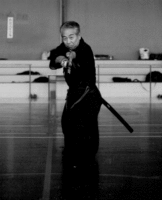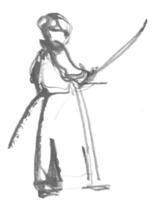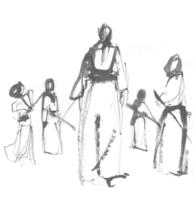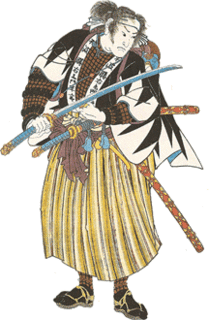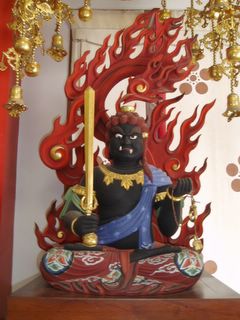After a visit to the Atsuta shrine (熱田神宮) in Nagoya, Japan I was inspired to dig into the history of the famous sword which is housed there. It is not possible to see the sword, or even enter the shrine: this is a privilege reserved only for members of the imperial family and high ranking priests of the temple itself. The sword is one of the three imperial treasures
[1] of Japan and has a fascinating history, going to the very heart of Japanese Shintoism.

Kusanagi-no-Tsurugi (草薙の剣 Grass cutter) is a legendary Japanese sword, the history of which dates back to the legend of when the Japanese god of storms, Susano-O no Mikoto, encountered a grieving family headed by Ashi na Zuchi. The elder told that his family was ravaged by Yamata no Orochi, the fearsome 8-headed serpent of Koshi, who consumed seven of the family's eight daughters and was coming for his final daughter, Kushi-Nada-Hime. Susano-O proceeded forward to investigate the creature, and after an abortive encounter he returned with a plan to defeat it. In return, he asked for Kushi-Nada-Hime's hand in marriage which was agreed. Transforming her temporarily into a comb to have her company during the battle, he set his plan in motion.
He instructed 8 vats of sake to be put on individual platforms positioned behind a fence with 8 gates. The monster took the bait and put each of its heads through each of the gates. With the necessary distraction provided, Susano-O attacked and slew the beast. He decapitated each of the heads and then proceeded to the tails. In the fourth tail, he discovered a great sword inside the body of Yamata no Orochi which he called Murakakumo no Tsurugi (Two-edged-straight-sword-of-the-village-of-the-clustering-clouds). To settle an old grievance, he presented to his sister, the sun-goddess Amaterasu Omikami.
Amaterasu entrusted the Imperial Regalia
[1] to her grandson Ninigi when he descended to the Japanese Islands. Ninigi’s decent to earth established the divine origins of the Yamato clan. He married a descendant of the storm god Susano-O and had a son Jimmu; he was the first Emperor of Japan. The Imperial Regalia are said to have passed from emperor to emperor until later in the reign of the 12th emperor, Keiko, the sword was given to the great warrior, Yamato-Dake as part of a pair of gifts given by his aunt, Yamato-Hime, to protect his nephew in peril.
These gifts came in handy when Yamato-Dake was lured onto open grassland during a hunting expedition by a treacherous warlord. The lord had fiery arrows fired to ignite the grass to trap Yamato-Dake in the field and have him burn to death. He also had the warrior's horse killed to prevent his escape. Desperately, Yamato-Dake used Murakakumo no Tsurugi to cut back the grass to remove fuel from the fire, but in doing so, he discovered that the sword enabled him to control the wind around him to make it move in the direction he swung. Taking advantage of the magic, Yamato-Dake used his other gift, fire strikers, to enlarge the fire in the direction of the warlord and his men and used the winds controlled by the sword to sweep the blaze toward them to kill them. In triumph, Yamato-Dake renamed Murakakumo no Tsurugi as Kusanagi (Grass cutter) to commemorate his narrow escape and victory. Eventually, Yamato-Dake married and fell in battle with a monster after ignoring his wife's advice to take Kusanagi with him.
At one time, the emperor possessed a real sword with this name. Along with the jewel and the mirror, it was one of the three imperial regalia until the Battle of Dannoura (1185), a naval battle that ended in the defeat of the forces of the child Emperor Antoku at the hands of Minamoto no Yoshitsune. Upon hearing of the defeat, the emperor's grandmother led the Emperor and his entourage to commit suicide (by drowning) in the waters of the strait along with three important artefacts which included Kusanagi. Although the enemy managed to stop a handful of them and recovered two of the three regalia of the Emperor, Kusanagi was never found. Emperor Sujin, ordered the fashioning of a replica of Kusanagi which can be found at the Atsuta Shrine in Nagoya. The actual Kusanagi
[2] is likely to have been a sword in the style of the Bronze Age, typically double-edged and straight (very much different from the more recent sabre style katana, with its typical curved single-edged blade).
[1] The Japanese imperial regalia, "Sanshu no jingi", or "Three Sacred Treasures", consisted of the sword "Kusanagi no tsurugi", the jewel "Yasakani no magatama", and the mirror "Yata no kagami".
[2] The complete name of the Imperial sword is Kusanagi no-tsurugi which means "grass parting two-edged straight blade”.
 Another superb and instructive iaido seminar is over. It never ceases to amaze me how much one can learn in a weekend and how much pain one can experience in one's knees after two days of shinkage ryu iaido.
Another superb and instructive iaido seminar is over. It never ceases to amaze me how much one can learn in a weekend and how much pain one can experience in one's knees after two days of shinkage ryu iaido.